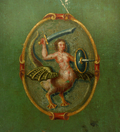conventional title Physiologus was because the author introduces his stories from natural history with the phrase: "the physiologus says", that is, "the...
20 KB (2,457 words) - 14:54, 29 October 2024
Bern Physiologus (Bern, Burgerbibliothek, Codex Bongarsianus 318) is a 9th-century illuminated copy of the Latin translation of the Physiologus. It was...
2 KB (202 words) - 17:17, 16 January 2022
Siren (mythology) (section Physiologus and bestiaries)
leading to the commingling involve the treatment of sirens in the medieval Physiologus and bestiaries, both iconographically, as well as textually in translations...
56 KB (5,644 words) - 02:50, 6 November 2024
allegorically in the writings of Christian fathers as well as in the Physiologus and bestiaries. Aristotle, Pliny, Nicander, Aelian The standard lore...
64 KB (6,447 words) - 15:29, 28 October 2024
The Icelandic Physiologus is a translation into Old Icelandic of a Latin translation of the 2nd-century Greek Physiologus. It survives in fragmentary...
11 KB (1,302 words) - 16:19, 3 October 2024
According to the tradition of the Physiologus and medieval bestiaries, the aspidochelone is a fabled sea creature, variously described as a large whale...
22 KB (3,161 words) - 22:31, 17 October 2024
déndron peridéxion) or perindens is a mythological tree discussed in the Physiologus, an early Greek-language Christian didactic text and compendium, and...
8 KB (875 words) - 00:25, 6 January 2024
Northumberland Bestiary (section Physiologus)
inspired by the Greek text the Physiologus as well as various Hexaemeral texts. Latin reproductions of the Physiologus fall into four groups. Version...
17 KB (2,273 words) - 14:37, 17 October 2024
318 – Physiologus Bernensis". e-codices. Retrieved 11 September 2022., facsimile, fol. 13v Woodruff, Helen (September 1930). "The Physiologus of Bern:...
211 KB (20,113 words) - 15:37, 15 November 2024
Septuagint version of the book of Job, reappearing in the Greek Christian Physiologus of the 3rd or 4th century A.D. It is found in Medieval bestiaries such...
5 KB (594 words) - 11:49, 21 August 2024
('sea-reek') and lyngbakr ('heather-back'). The aspidochelone of the Physiologus is identified as the potential source for the hafgufa lore. Although...
35 KB (2,642 words) - 06:25, 9 November 2024
fox-sized ants that dug up gold in sandy areas. Some versions of the Physiologus said they came from Ethiopia, while Herodotus claimed they were located...
6 KB (552 words) - 16:27, 3 November 2024
from a single creature called the aspidochelone in the Physiologus. The Icelandic Physiologus contains two illustrations of the aspidochelone, one with...
3 KB (319 words) - 08:46, 6 August 2023
later popularized was an anonymous 2nd-century Greek volume called the Physiologus, which itself summarized ancient knowledge and wisdom about animals in...
21 KB (2,496 words) - 07:20, 25 October 2024
Mandrake (section Physiologus)
Version, Song of Songs 7:12–13 In the Christian allegorical bestiary Physiologus, the chapter on the elephant claims that the male becomes minded to create...
67 KB (6,729 words) - 21:44, 13 November 2024
An illustration of the Caladrius' prophecies from the 1588 edition of the Physiologus. Copperplate by Pieter van der Borcht (I)....
6 KB (744 words) - 23:04, 14 September 2024
Tolkien's poem "Fastitocalon" echoes a second-century Latin tale in the Physiologus of the Aspidochelone ("round-shielded turtle"); it is so large that sailors...
103 KB (11,428 words) - 21:58, 15 November 2024
Ashmole Bestiary. The connection between the ancient Greek didactic text Physiologus and similar bestiary manuscripts is also often noted. Information about...
26 KB (2,947 words) - 03:41, 12 August 2024
Catching of pearls, Bern Physiologus (9th century)...
63 KB (7,903 words) - 21:54, 9 November 2024
name albatross is also derived by corruption of the Spanish word. The Physiologus, a didactic Christian text from the 3rd or 4th century, claims that pelicans...
100 KB (10,025 words) - 02:23, 6 November 2024
Georgian translations (this last is found in Shatberd ms 1141 along with Physiologus and De Gemmis). The first section discusses the canon of the Old Testament...
21 KB (2,665 words) - 12:46, 17 October 2024
the lion as royal animal in particular is due to the influence of the Physiologus, an early Christian book about animal symbolism, originally written in...
38 KB (4,020 words) - 08:33, 3 November 2024
1904. 122–123 Getlein & Getlein, 72 According to Physiologus text; see Nürnberg, 74 "Epiphanius Physiologus: Fox". spcoll.library.uvic.ca. The Landsknechts[permanent...
20 KB (2,522 words) - 19:43, 1 November 2024
Hommel include: Die äthiopische Übersetzung des Physiologus (1877) – Ethiopian translation of the Physiologus Die Namen der Säugetiere bei den südsemitischen...
4 KB (416 words) - 16:50, 22 September 2024
time. All true Latin Bestiaries take their origin from the Greek work Physiologus, though the word can colloquially be used with less specificity. Bestiaries...
10 KB (1,320 words) - 15:28, 3 September 2024
Myrmecoleon was a mythical ant–lion hybrid written about in the 2nd century AD Physiologus, where animal descriptions were paired with Christian morals. The ant-lion...
37 KB (4,086 words) - 17:06, 7 October 2024
content, often referred to as bestiaries. The origin of these is the Physiologus, a collection of allegories about animals with Christian interpretations...
66 KB (8,413 words) - 18:36, 20 May 2024
moral. The medieval bestiary ultimately derives from the Greek-language Physiologus, a text whose precise date and place of origin is disputed, but which...
15 KB (1,562 words) - 05:16, 14 August 2024
for the coat of arms was probably derived from the 2nd-century book Physiologus. There are several legends about the mermaid. The City's literature and...
9 KB (1,027 words) - 15:49, 27 October 2024
retinue. Aspidochelone, colossal sea monster from the medieval bestiary Physiologus. Morana, a goddess associated with the winter, death and rebirth. Death...
43 KB (6,054 words) - 05:16, 16 November 2024




























